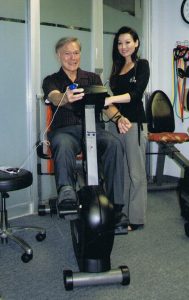This article originally appeared in the February 2014 issue of Generations Magazine.
Cardiac rehabilitation, as defined by the American Heart Association, is a medically supervised program to help patients who have sustained a heart attack, undergone heart surgery (bypass) or those with identified risk factors (coronary artery disease or angina). Cardiac rehab is used to stabilize, slow or even reverse the progression of cardiovascular disease, ultimately reducing the risk of heart disease, another heart attack or even death.
 A physical therapist specializing in cardiac rehab will perform an evaluation and develop a plan consisting of patient education on diet, relaxation techniques, aerobic training and strengthening exercises. The therapist will closely monitor vital signs, such as blood pressure, heart rhythm and rate, and oxygen saturation levels.
A physical therapist specializing in cardiac rehab will perform an evaluation and develop a plan consisting of patient education on diet, relaxation techniques, aerobic training and strengthening exercises. The therapist will closely monitor vital signs, such as blood pressure, heart rhythm and rate, and oxygen saturation levels.
The therapist should also prescribe a safe exercise program, with appropriate duration, frequency and intensity. While everyone can exercise at a gym or at their home after a cardiac event, a rehab program offers a safe and effective environment to improve your heart health with the supervision of a medical professional.
The benefits of cardiac rehab are well documented. Studies show that there is a 95 percent three-year survival rate for those who attend rehab, versus a 64 percent survival rate for those who do not.
A great rehab program can help people make life changes and achieve a level of health that may even be better than it was before the cardiac event.
Click here to learn more about cardiac rehabilitation at Moon Physical Therapy!




